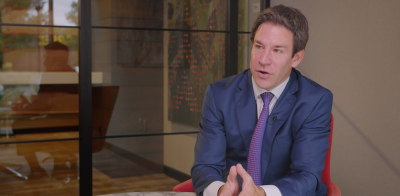In my previous strategy note, “Where do you go for growth? The time for the right alts is still now,” I introduced middle market private equity (PE) as a potential solution for growth. In this follow-up note, I’m going deeper into the important questions about this asset class: What are the market conditions creating this opportunity? And how can investors pick structures for accessing it?
Let’s start with the market.
The market
The continued, near-historic levels of equity strength have confounded most investors (including me). Anyone who focuses on the typical fundamental and liquidity drivers of market strength or weakness has been left scratching their heads. Here’s what these headwinds look like.
- Money supply/Fed balance sheet: Balance sheet continues to shrink at an aggressive pace and money supply has already shrunk at historic levels—albeit after a 42% surge during the pandemic.
- Valuations: Valuations measured by equity multiples (19.9X next 12-month earnings) or equity risk premia (by equity risk premia over treasuries) were only richer in the late stages of the dot-com bubble—and in multiple terms—equities were only richer during the dot-com bubble or in the heady days of 2021.
- Corporate margins: They haven’t dropped as dramatically as some had predicted—but they have dropped, nonetheless. The expectation for margins to re-expand going forward, as nominal gross domestic product (GDP) growth slows, appears dubious at best.
- Bank lending: It’s tough to grow an economy with a stagnation in bank lending.
- Labor market: The labor market is the ultimate lagging indicator, but declining withholding-tax growth tends to be a very accurate indicator for when the consumer finally runs out of steam. After all, as the consumer goes, so goes the U.S. economy. Withholding-tax growth went negative in Q2 and has started out Q3 in a slightly deeper contraction. As a reminder, it previously took until Q3 2001 and Q4 2008 (both well into bear markets) for withholding-tax growth to turn negative. The only false signal withholding-tax turning negative has given for a recessionary outcome was in 2018—and soon after that, the Fed was able to pivot to cuts.
In other words, this is starting to feel a lot like 2021 or even the late 1990s when the only way to keep up with equity markets was to be 100% net long (or greater) to equity markets.
Irrational exuberance
We all know the market can stay irrational (or at least overvalued) for a long time. But it’s equally true reality sets in eventually—and typically within a year or two.
Our best estimate now is that reality will be driven by a modest recession, which will cause another downturn in earnings (instead of expected gains the next two years). However, the recent U.S. credit rating downgrade could continue to lead to a modest decline in equity prices.
The more irrational exuberance (had to pull out that old Greenspan expression) and/or elevated valuations continue in the short term—and the more richly equities are valued in the present—the bleaker the return outlook for equities will be over the medium to long term.
The current situation reignites the urgency to focus on the northwest quadrant of the efficient frontier strategies as an equity replacement.
Middle market private equity
Alright, onward to middle market private equity with an emphasis on secondaries.1
What makes the middle market private equity opportunity so compelling now? And will that opportunity persist for the next several years or longer?
The second golden age of PE investing
We very well may have entered the second golden age of PE secondary investing. PE secondaries can be purchased at a substantial discount to net asset value (NAV), and investors have the potential to benefit immediately from revaluing the purchase back up to NAV. While the first golden age of PE secondary investing was driven by the acute liquidity needs during the global financial crisis (GFC), the current opportunity is driven by a rational rebalancing of a vast asset class. As you can see from the following chart, the discounts today are not as dramatic as they were during the GFC, but they are as compelling as they have been in the last ten years.
Secondary pricing

Greenhill Secondary Pricing Trends & Analysis, June 2022.
PE assets have ballooned
Due to the historical performance success of private equity, PE assets have ballooned to approximately $5.5. trillion.
Staggeringly, approximately 70% of PE capital has been deployed over the past five years at, generally, higher valuations than previously experienced in the prior 15 years (as you can see in the chart below). Remember, private equity valuations were not immune to the forces that drove all asset prices higher, namely limitless money, supply growth, and lower and lower interest rates.
And guess what? The vast, vast majority of that capital came from institutions and mega qualified purchasers (QPs).
As you’ll note in the following chart, the amount of capital raised from smaller investors represented by the “evergreen PE fund capital raise” is actually hard to even see. So, the next time someone tells you retail investors chase returns or buy tops, please remind them that just about every investor class chases returns and buys tops—even institutions!
Vast majority of PE AUM invested by institutions and mega qualified purchasers

Source: Preqin as of December 31, 2022.
Many institutions are overweight PE
Unfortunately (or fortunately), this dramatic ramp-up in PE allocations ran into the galactic mean reversion and, as equity and bond markets dropped in value in the year-and-a-half since the end of 2021, many institutions found themselves overweight PE.
How did this happen? Even after the recent rally, the S&P 500 is still down 4%, the Bloomberg Barclay’s Agg is still down 13.4% and real estate equity investments have provided another kick in the teeth—not to mention venture capital or early-stage growth investments. In contrast, nominal GDP and the labor market have been on a tear over the same time period.
In order to rebalance (or in some cases, just to get back to the limit in their investment policy statements), institutions are turning to the secondary market to raise liquidity. If they need to free up additional allocation room to make fresh allocations to newer, cleaner vintages, guess what: they need to sell down more PE fund interests.
The growth of PE
Given the dramatic growth in PE as an asset class, and the strategic need for secondary sales, how large is the current market relative to history? The rough math is if 5% to 15% of the PE market transacts over the next five years, it will translate to roughly $275 billion to $825 billion during the next five years (admittedly a wide range).
So, in theory, there should be plenty to do in secondaries for a while. As you can see from the next chart, transaction volume has grown dramatically the past eight years. That means another way at getting to the market size is just to assume the current rate of $100 billion to $130 billion continue the next five years and you are in the middle of the range.
Secondary market transaction volume

Source: Jefferies, “Global Secondary Market Review, January 2023”
How can investors access PE?
There are two primary structures investors can now use to access private equity: drawdown and evergreen.
In many ways, the evergreen structure is potentially superior to legacy (frankly archaic) drawdown vehicles, particularly for non-mega QPs and institutions.
If you look at how these two structures work, you can easily see why.
Drawdown structure
Capital commitment: A private equity firm asks for a capital commitment and an investor commits capital.
Fees on committed capital: The investor now has the dubious honor of paying fees on committed capital instead of invested capital. That leads to the infamous J curve effect, where an investor has to potentially wait four to six years for at least some profitable underlying investments to offset the fees paid on committed capital, and then to break even on the committed capital amount. From that point forward, the investment gains tend to dwarf the fees.
The private equity J-curve

Capital calls: Over a multiple year period, the investor “enjoys” periodic capital calls when the money is invested (occasionally at the worst possible time, like when they are light on cash for whatever reason).
Realization events: Further on in time, the investor is gradually paid back on realization events (for example, when individual companies are sold).
What to do with the capital: The investor then has the joy of trying to figure out what to do with the capital again.
Thirteen years: Often times, investors may wait longer than a decade to receive back all of the committed capital and profits. And then the cycle begins again. Keep in mind, the average vintage life for PE drawdown structures these days is approximately 13 years
On the other hand, the evergreen structure shows improvements on the traditional drawdown structure in a number of key areas:
Evergreen structure
Capital in action: Invested capital has the ability to be put to work immediately, typically on a monthly time frame—and there is no long, drawn-out capital call period.
Better timed fees: Fees are only charged on invested capital. That means the J curve effect is mitigated in an evergreen structure focused on secondaries and direct investments with limited primary exposure.
Efficient redeployment of capital: Capital from realization events can be efficiently redeployed within the fund structure by a professional team—that means they could have the potential benefit of redeployment at better pricing, sectors/industries, companies, etc. But the investor does not have to repeatedly figure out what to do with small percentages of the original investment amount.
Available liquidity: There is typically limited liquidity available to investors per quarter to rebalance exposures or for use in the case that an investor has a life event and needs liquidity. So, investors don’t have to necessarily wait 10-plus years to receive their capital back (though there are limitations built into the evergreen fund structure to make sure the aggregate investor pool is never a forced seller at an inopportune time—think Q4 2008/Q1 2009 or March 31, 2020).
Diversification2 at relative ease: Since investors typically only allocate a small portion of their assets to alternatives (and only a portion of their alternative investments to PE), it can be challenging for an investor to achieve diversification of manager, vintage, size and/or sector through drawdown structures. However, in evergreen structures—particularly in those with a timely emphasis on secondaries—diversification of vintage, manager and sector is potentially much easier to achieve.
More flexible access: This includes lower minimum investment size, 1099 tax treatment, and unlimited Employee Retirement Income Security Act (ERISA) and individual retirement account (IRA) capacity.
Evergreen structures pull ahead
So, now you should be able to see how using evergreen RIC vehicles to pursue middle market private equity has the potential to provide the efficiency and flexibility that individual investors need when accessing this space.
In fact, middle market PE with a heavy emphasis on secondaries packaged in a regulated investment company (RIC) structure is the first time in my career I have seen slower moving, smaller investors actually be in a position to take advantage of those faster moving, larger investors that got a little too far over their skis in terms of their PE allocations in the last five years.
That’s why—when middle market private equities are pursued through evergreen RIC vehicles—they are truly the epitome of the democratization of Alts.
Democratizing alts
Remember, the democratization of alts has historically always been about taking institutional alternative strategies (like private credit or multi-strategy investment structures) and packaging them in a way that smaller investors could access without diluting the investment outcome.
That’s easy to say, but it actually took well over a decade for the industry to achieve this goal for a select subset of alternative strategies.
Luckily, individual investors can now benefit from the work the industry has done and enjoy a truly democratized alt—how sweet it is!
Evergreen structures vs. full cycle PE strategy?
There is a subtle, but important nuance I would like to consider before wrapping up this strategy note:
Should an investor only select evergreen structures that focus solely on secondaries, or are they better off utilizing a full cycle PE strategy that can opportunistically ramp up secondaries when the opportunity is as rich as it is today?
Well, like many things in life, there is no absolute definitive answer to this question.
However, right now a core/satellite approach probably makes a lot of sense (where an investor makes a larger core allocation to a full cycle fund and a smaller, more opportunistic allocation to a secondary only fund).
Here’s why:
Pivoting from secondaries: Full cycle funds can ramp up allocations to secondaries in market environments like 2008 through 2010, or 2022 through 2025, and then gracefully and efficiently pivot back to primary PE and direct co-investment classic PE when the secondary opportunity diminishes.
Historically, as you can see from the following chart, there are times like 2008 through 2010 (and now) when secondary pricing looks great, and other times like 2014 through 2018 when pricing is not as attractive.
Secondary pricing

If you over-allocate to secondary funds, you may find yourself in a position where you have to redeploy that capital rapidly in two or three years.
Scaling into the opportunity: This is an important logistical point to emphasize when selecting which full cycle PE fund currently focused on secondaries in which to invest. The secondary exposure will be much more impactful on investment performance for smaller funds that are ramping up assets under management (AUM) into the current attractive pricing and volume environment.
Which is to say it will be much easier for a $500 billion to $1 billion fund to double and triple in size over the next several years (and make the secondary opportunity count) than it will be for a $10 billion or $12 billion fund.
Just like for private credit today, current and potential dry powder matters for monetizing the opportunity in secondaries.
The time for the right alts is still now
Market conditions will always present challenges, but access to innovative alternatives is helping investors achieve their financial goals in ways that would have previously been unheard of.
The conclusion is clear, the opportunity in middle market PE with a heavy emphasis on secondaries is another example of why “the time for the right alts is still now.”
Investing in alternatives is different than investing in traditional investments such as stocks and bonds. Alternatives tend to be illiquid and highly specialized. In the context of alternative investments, higher returns may be accompanied by increased risk and, like any investment, the possibility of an investment loss. Investments made in alternatives may be less liquid and harder to value than investments made in large, publicly traded corporations. When building a portfolio that includes alternative investments, financial professionals and their investors should first consider an individual’s financial objectives. Investment constraints such as risk tolerance, liquidity needs and investment time horizon should be determined.




